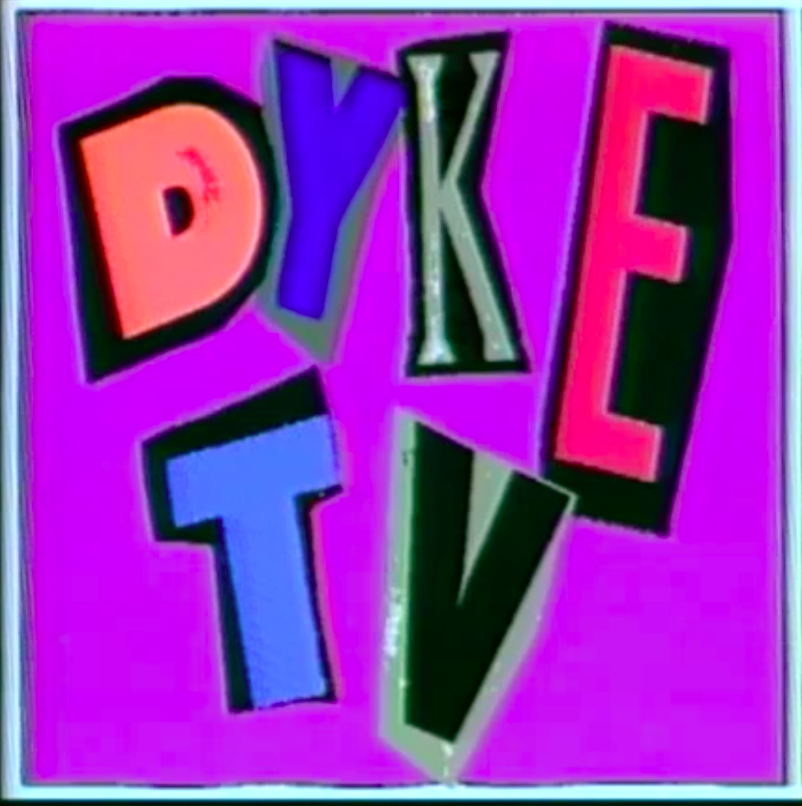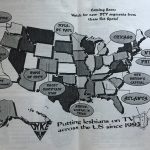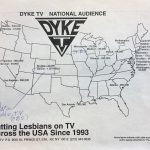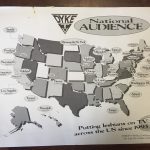Dyke TV Guide
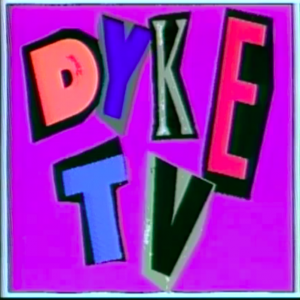
Dyke TV was a groundbreaking television program founded in 1992 by Ana Simó, Maria Patierno and Linda Chapman. The weekly, magazine style show featured news, special reports, art and humor was on the air from June of 1993 until its last show in 2005. Through public access television, the radical grassroots programming that began in New York City quickly spread reaching millions of viewers across the United States. With strong ties to the AIDS activism of ACT UP and the radical visibility politics of the Lesbian Avengers, the show devotedly covered queer activism and the tagline proudly proclaimed that this was “television to incite, subvert, provoke and organise.” All this while as founder and Dyke TV Producer Maria Patierno recalls, when Dyke TV began broadcasting in 1993, there was not a single gay character on TV. The creators, the volunteer based production team and all those who contributed fought for their visibility, and in doing so they documented their history and attempted to build their future.
In the spirit of studying dyke tv for its historical value, and turning the archives inside out, I began hosting screenings with friends. We’d sit around and talk long after our weekly episode, and wonder about how we got from there to where we are now. While we learned lesbians belonged on TV through the endurance of the L Word, Dyke TV tapes were growing mouldy in boxes before being donated to the archives. Through these conversations we came to understand the world building intention in Dyke TV, how they envisioned a different landscape for other lesbians, socially, politically and culturally. Not only do we appreciate Dyke TV for what it was, but we are trying to understand why it was lost to us, that it wanted to be there for us, and the message that its still trying to get across.
National Audience
From its first city broadcast, the show expanded rapidly. At its peak distribution, Dyke TV could be viewed from 78 public access channels throughout the United States. The network of watchers, sustainers and collaborators was far greater than viewership maps suggest. There were correspondents reporting news, amature stringers crafting stories, and home videos being sent in from places that couldn’t access the show. Although there had been wide circulation of lesbian publications in earlier years, particularly The Ladder magazine, published by the Daughters of Bilitis, this is unprecedented documentation of a lesbian media network.
Grassroots Media Production
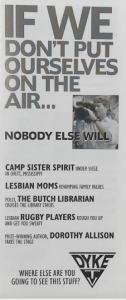
“If anybody wanted to do a story we let them do it. We were there to let people voice whatever they wanted to, whatever issues or topics that were of interest to them.” Maria Patierno
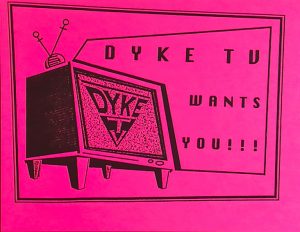 “We had to do this, we had to make this show. It wasn’t like you came into an institution that already existed and sort of work along with its like we created the institution we wanted.” Sally Sasso
“We had to do this, we had to make this show. It wasn’t like you came into an institution that already existed and sort of work along with its like we created the institution we wanted.” Sally Sasso
This was not just a hope, the active engagement and participation of viewers as collaborators and creators of the program was integral to the mission of Dyke TV, such that from their first year they began offering workshops to teach community members foundational video production skills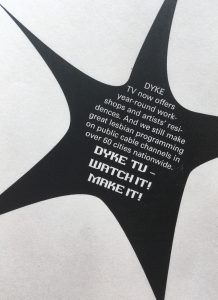 . Everything was shot in high 8, making the medium accessible even outside the studio. Segments that were produced in these video workshops were often aired on the weekly program as a chance to showcase newcomers work. In consistantly telling these stories Dyke TV was investing in its goal to put Dykes in charge of their own image and narrative. As their workshops expanded in attendance and as they moved into teaching adobe illustrator, photoshop, and advanced web design, they contributed to skills Dykes could use in mainstream media production.
. Everything was shot in high 8, making the medium accessible even outside the studio. Segments that were produced in these video workshops were often aired on the weekly program as a chance to showcase newcomers work. In consistantly telling these stories Dyke TV was investing in its goal to put Dykes in charge of their own image and narrative. As their workshops expanded in attendance and as they moved into teaching adobe illustrator, photoshop, and advanced web design, they contributed to skills Dykes could use in mainstream media production.
Questions:
What does it mean to bring this to a queer audience now?
What potential does Dyke TV have as archival material to carry out its mission to “Incite, subvert, provoke and organise”?
How did Dyke TV function as a world making mechanism and how do we see their imagined world reflected in our own?
How has the word and the embodied identity of “Dyke” resisted institutionalization and how does it continue to resist, even now?
